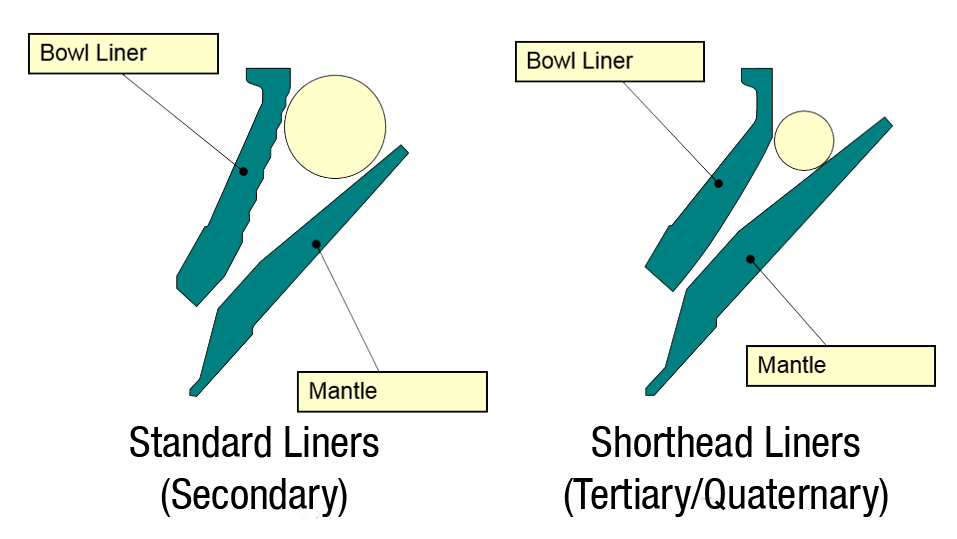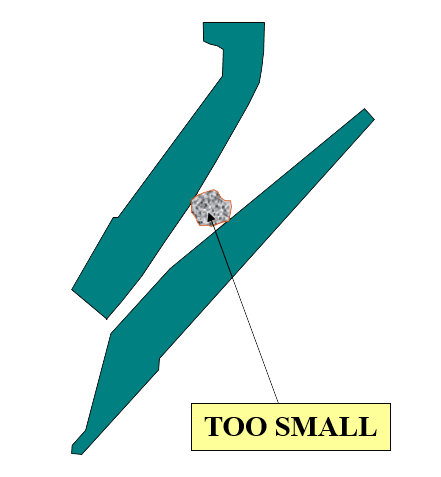Introduction
Cone Crushers were developed more than a century ago to provide secondary, tertiary and even quaternary material reduction.
Like other compression crushers, Cone Crushers feature a crushing chamber or cavity where the rock is crushed to a smaller size. The crushing chamber in a Cone Crusher is the space created between the mantle (the moving piece of steel) and concaves (the stationary piece of steel). The mantle and concaves are protected from daily wear by replaceable manganese liners.
Selecting a Cone Crusher liner
A wide range of liners are available to accommodate coarse and fine feeds, but which you choose depends on several factors. The most important factor in Cone Crusher liner selection is the feed.

You should have a well-graded feed going into the crushing chamber. A well-graded feed is generally considered as:
- 90-100% passing the closed-side feed opening. Some people look at 80% of the open side as well and select the smaller of the two.
- 40-60% passing the midpoint.
- 0-10% passing the closed-side setting.

A well-graded feed to the Cone Crusher.
You want to match the entire feed gradation, not just the feed size, so that you utilize the entire chamber. It is important to utilize as much of the crushing chamber as possible to get the required reduction and desired throughput.
Plant feed size and the output from your previous crushing stage defines your top feed size, which will give the maximum cavity opening. The cavity opening should not be too big in relation to the top feed size. Cavity openings that are much larger than the feed size lead to poorly utilized reduction and liners.
If the feed size is too small, the majority of the crushing takes place in the lowest portion of the cavity, which means the bottom of the liners will wear away faster than the top of the liners. The production will decrease due to the poor reduction ratio. The power limit of the crusher will be exceeded at minimal volume level, and you’ll run the risk of improper bearing alignment.

Most of the wear on crusher liners occurs right before the parallel zone (the smallest space between the mantle and the concaves where the final crushing takes place), but this wear will be accentuated if the feed is too small, and you’ll end up with a bowled-out pocket before the parallel zone way too soon.
On the other hand, if the feed size is too coarse, the feed material will keep percolating around the feed opening, causing the top of the liners to wear away faster. Because the feed opening is bridged over, throughput is reduced and production decreases. The output gradation will be coarser, and the product will be slabby, not cubical. The volume limit will be exceeded at minimal power draw.

Understanding your gradation going into the crusher helps you to choose the right liner configuration necessary to achieve your production goals. The right liner selection gives you a better nip and more room to adjust other parameters, such as closed-side setting.

When to change Cone Crusher liners
Liners that exceed their intended operating life will cause mechanical problems with the crusher. A liner that is pushed too long will flex and crack, and the flexing of a thin or cracked mantle will cause severe seat surface damage.
Although there is no foolproof way to tell when the liners are worn out, here are two indications it is time to change the liners:
1. Production level
When you see a 10% or more drop in production level or throughput, it is a good indication the Cone Crusher liners need to be changed.
2. Liner thickness
If the liner is wearing evenly throughout the chamber, you should consider changing it when it has worn down to about 1” (2.5 cm) thick at the bottom. At about 3/4” to 5/8” (1.9 cm to 1.6 cm) thick, the liner will crack, causing the backing material to begin to disintegrate. This will cause the liners to break loose. If the liners break loose, continued operation could destroy the seat on the support bowl or the head of the Cone Crusher.
Some Cone Crushers feature an automatic liner change reminder. When new mantle and concave liners are installed, the automatic reminder is reset. As the crusher operates, the system tracks production capacities and calculates the liner wear rate. When the cone liners reach the maximum wear point, the system sends a flashing reminder to “Change Cone” on the cone setting meter. After the wear parts are changes, reset the automatic reminder system and continue efficient and reliable crushing.
An important item to note: You should never place a new concave liner in a crusher with a worn mantle or a new mantle in a crusher with a worn concave liner. Mating new and worn components will change the profile of the crushing chamber and restrict the feed from entering the crushing chamber, which will reduce the tons per hour produced.
Improve liner life with correct feed distribution
To get the most wear life out of your crusher liner, as well as ensure optimal crusher performance, it is necessary to feed the crusher correctly.
Incorrect feeding methods
A segregated feed distribution, one that sends large material to one side of the crusher and small material to the other side, will lead to poor liner wear. Moreover, it will cause ring bounce — when pressure in the chamber is higher than the pressure holding it down, as well as more oversized products and poor particle shape.

A segregated feed, with coarse material on the left and fine material on the right.
An off-centered feed, one that sends a majority of the feed to one side of the crusher, will also lead to poor liner wear, ring bounce and poor particle shape. When you don’t use the entire chamber, you are not maximizing crusher performance.

An off-centered feed, with a majority of the feed on the right side.
Correct feeding method
The best way to ensure optimal liner life is to choke feed your Cone Crusher. Choke feeding allows a full chamber with material on top to help force the material in the chamber through. Choke feeding also minimizes the air pockets in the crushing chamber to reduce the creation of flat, elongated particles.
Preventative maintenance and documentation
Another way to get the most wear life out of your Cone Crusher liners is to conduct regularly scheduled routine maintenance and document the information along the way. This will help you understand how your liners wear, identify wear patterns and understand how the wear affects your production. It will also help you to make necessary changes to improve your production.






